Take the weather with you Teach article
Karen Bultitude introduces a set of simple, fun and memorable demonstrations using everyday ingredients to explain meteorological phenomena.

/ iStockphoto
Understanding our impact on the environment is increasingly important, with both scientific and societal implications now covered in various parts of most school curricula. With so much talk about climate change, it is useful to learn about some of the atmospheric phenomena that actually make up our climate.
The following demonstrations help clarify some aspects of these phenomena and bring the concepts to life in an engaging and memorable way. They were developed as part of the British Council’s ZeroCarbonCityw1 campaign to support teachers and scientists throughout the world in explaining basic concepts of environmental science. The demonstrations can be used in a variety of ways: individually, to emphasise particular concepts during class; as a collection, for example as a workshop or demonstration lecture; or as set tasks for students to complete themselves. Further suggestions for activities related to environmental sciences can be found online.
Cloud in a bottle
Create your very own mini-cloud.
Materials
- A 500 ml colourless plastic bottle with cap
- Water
- A teaspoon
- A match
Instructions
- Place approximately one teaspoonful of water into the plastic bottle and swirl it around inside the bottle.
- Light the match and make sure it is burning well, then drop it into the bottle.
- Quickly screw the cap on tightly, then squeeze the bottle with your hand five or six times, after which you should see a cloud form in the bottle, then disappear when you squeeze it.
- Pass the bottle around the class, instructing them to squeeze and release the bottle themselves to see the cloud.
You can also watch a video of the activity onlinew3.
How does it work?

/ iStockphoto
Clouds are formed when water vapour in the air cools down due to the expansion of the rising air mass, and then condenses to droplets on condensation nuclei such as dust particles, ice or salt. In this demonstration, the condensation nuclei are provided by the smoke from the match, which contains particles of uncombusted hydrocarbons. The temperature is changed by squeezing the bottle: the amount of air within is constant, but squeezing the plastic bottle lowers the volume of the gas, raising the temperature slightly. When you stop squeezing the bottle, the volume increases, thereby causing a slight lowering of the air temperature inside. If the air inside the bottle has a relatively high humidity (which is ensured by adding the teaspoonful of water at the beginning) then the temperature drop is sufficient to cause the water to condense on the dust particles, forming a cloud.
Links to atmospheric phenomena
Next time you see a fantastic sunset over an urban area, take a moment to think about what is causing the beautiful colours: its origin actually lies in the tiny smoke particles and other pollutants that have been emitted into the atmosphere. Just like in the plastic bottle, these smoke particles encourage water droplets to condense around them, forming clouds. The scattering of the Sun’s rays amongst the clouds is what creates the beautiful sunset. There are some concerns that air pollution will therefore have a detrimental effect on the weather, since more air pollution leads to increased cloud formation, which could in turn lead to more rain in certain areas and a significant change to wider weather patterns (floods in some areas; droughts in others).
Whirling orb
This is a beautiful and fascinating demonstration of turbulent weather effects.
Materials
- A small clear plastic bottle (the more rounded the bottle, the better), including a tight-fitting lid
- Liquid hand wash (soap) that contains glycol stearate
- Food colouring
- Water (from a tap)
Instructions
- Fill the bottle about one-quarter full with the hand wash, then add a few drops of food colouring.
- The demonstration won’t work if the mixture foams: turn on the tap so that only a trickle of water is coming out, then carefully fill the bottle up to the very top.
- Screw the lid onto the bottle, and swirl the bottle around a few times (with the lid pointing upwards). If any foam forms, take the lid off and trickle some more water into the bottle, letting the foam run over the edge. Put the lid back on (tightly).
- Move the bottle around: you will be able to see turbulence patterns (streaks and swirls) in the liquid.
How does it work?
Moving the bottle around causes the soap and water mixture inside to move. The glycerol stearate makes the patterns of flow visible, so you can see the directions in which different parts of the mixture are moving. Smooth lines forming in the liquid indicate laminar flow, which occurs when the liquid is moved slowly. If you make the liquid move faster (or change the direction suddenly) then the observed lines of fluid become more complex: this is turbulent flow.
Links to atmospheric phenomena
The Earth’s atmosphere is a kind of fluid that moves much like the liquid inside the whirling orb. Winds interact with the spinning atmosphere and create complex circulation patterns. Understanding the general circulation of the atmosphere is fundamental to the work of many different areas of climate change science – for example, in understanding and reducing the effects of both hurricanes and pollution.
Teabag rocket
This is a good visual demonstration of thermals – rising currents of warm air.
Materials
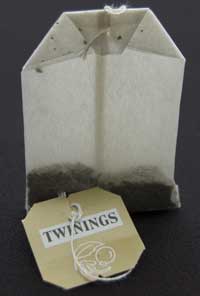 A traditional-style teabag
A traditional-style teabag- Matches
- A saucer or plate
Instructions
- Undo the teabag, removing the staple and string and disposing of the contents (the tea). Open up the teabag so it is a long cylinder of paper.
- Stand the open teabag upright on the saucer or plate.
- Use the match to light the top of the teabag.
- Watch as the flame burns down the teabag: just before it reaches the saucer, the teabag will lift off. The flame will go out, but the teabag will keep on rising.
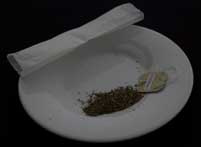 Tips for success
Tips for success
- This demonstration works best in a still room where there are no air currents, away from windows or air conditioning.
- Be careful to ensure that you use the right sort of teabag – it must fold out to produce the long cylinder of paper. Teabags without a string attached usually won’t work.
How does it work?
 The burning teabag heats up the air immediately above it. Hot air rises, so the warmer air will gradually rise up above the teabag, creating a rising current of warm air – a thermal. When the teabag has burnt down far enough, the lift from the thermal will be enough to overcome the force of gravity keeping the teabag on the saucer, and so it will lift up.
The burning teabag heats up the air immediately above it. Hot air rises, so the warmer air will gradually rise up above the teabag, creating a rising current of warm air – a thermal. When the teabag has burnt down far enough, the lift from the thermal will be enough to overcome the force of gravity keeping the teabag on the saucer, and so it will lift up.
Links to atmospheric phenomena
Thermals are the basis for various weather patterns. The Sun heats up the land, causing thermals to spiral upwards. Thunderstorms are giant thermal systems, and the vortex formation associated with tornados and hurricanes is also based on thermals. As an effect of global warming, more thunderstorms are expected to occur.
Tame tornado
This is a good visual demonstration of how tornadoes form.
Materials
- Two large (~2 l) empty soft drink bottles (must have rounded necks)
- A ‘tornado tube’ adapter (available from many science centres and museums or onlinew4). If you can’t find a tornado adapter, try placing a large washer (either metal or stiff rubber sealing ring) between the two bottles and fastening it all together with tape – the idea is to join the two bottles together so that the water can flow between them and they remain rigid (see images left and below).
- Water
Instructions
- Fill one of the soft drink bottles with water until it is approximately half full.
- Screw the ‘tornado tube’ adapter into the empty bottle.
- Invert the empty bottle and screw the opposite thread of the ‘tornado tube’ adapter into the water-filled bottle.
- Turn the whole contraption upside-down.
- Grasp the top and middle of the contraption and spin it in a circular motion – either clockwise or counter-clockwise.
- Once a vortex (whirlpool) forms in the upper bottle, stop spinning – you should see the vortex form throughout the liquid, and continue as long as there is liquid in the upper bottle.
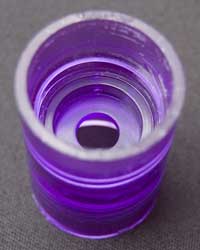
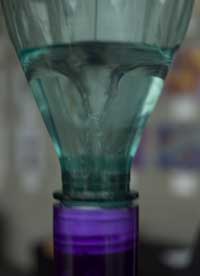
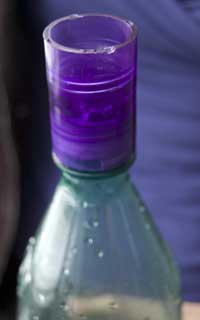
Tips for success
- If the vortex doesn’t work straight away, try reducing the size and increasing the speed of the circles you are making. Make sure that the bottles are held vertically and your circles are centred about the long axis of the contraption (it is common to make the mistake of twisting the contraption around the point where the bottles are joined together).
- Make sure you replace the plastic bottles if they get too bent out of shape – they need to be round to make a proper vortex.
- Leakage problems are common. Try using cling film or plumber’s (PTFE, polytetrafluoroethylene) tape to better seal the adapter around the bottles.
How does it work?
This demonstration produces a vortex similar to those observed in cyclones, tornadoes and whirlpools. As the water spins around the bottle, there is a downward pull formed due to the water passing through the opening into the empty bottle below. The initial small rotation caused by spinning the bottles gains speed as the water is sucked through the opening. As the rotation speeds up, the vortex forms.
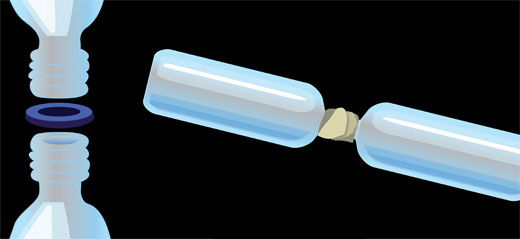
Images courtesy of Nicola Graf
Links to atmospheric phenomena
One of the predicted impacts of climate change is global warming: warmer air temperatures mean that thunderstorms are more likely to form, and tornadoes are formed in thunderstorms, where air starts moving in a circle. Updrafts and downdrafts within the thunderstorm force the rotating column of air to become vertical, creating the tornado. An increased number of thunderstorms is therefore likely to cause more hurricanes and tornadoes to form throughout the world.
Web References
- w1 – Further information about the British Council’s ZeroCarbonCity campaign is available here: www.britishcouncil.org/zerocarboncity.htm
- w3 – To watch a video of the cloud in a bottle, see: www.physics.org/interact/physics-to-go/cloud-in-a-bottle/index.html
- w4 – For an international supplier of ‘tornado tube’ adapters, see: www.101gear.com
- w5 – To watch a video of the tame tornado, see: www.physics.org/interact/physics-to-go/tame-tornado/index.html
- w6 – For more information on the STEM Directories, see: www.stemdirectories.org.uk
Resources
- Climate Challenge is an online game with associated support resources developed by the BBC: www.bbc.co.uk/sn/hottopics/climatechange/climate_challenge
- Oxfam have developed a week of activities about climate change to be run with children ages 9-11: www.oxfam.org.uk/education/resources/climate_chaos
- NASA has an excellent range of animations available relating to climate change: www.nasa.gov/centers/goddard/earthandsun/climate_change.html
Review
This article provides fun physics experiments with a link to the teaching of environmental sciences and particularly of meteorological phenomena, which are surprisingly not too large in scale to be simulated in a classroom.
The proposed demonstrations are simple, cheap and attractive, and at the same time don’t require special equipment, can be proposed to students of different ages, and can be expanded at different levels.
I recommend this article to science teachers from primary to secondary school. The experiments are suitable as warm-up activities to address various topics within physics and earth science curricula, such as: states of matter, phase transitions, gases, fluid dynamics, Earth’s atmosphere (temperature, pressure, humidity, clouds, general circulation, cyclones and tornadoes, for example), air pollution and climate change. It can also be used to start a discussion on climate change and sustainable development.
Comprehension questions:
- Which of the following is not an example of a condensation nucleus:
a) dust particle b) gas molecule c) ice crystal d) salt particle
- Thermals are:
a) sinking currents of warm air b) rising currents of cold air c) sinking currents of cold air d) rising currents of warm air
The article is also suitable for interdisciplinary activities involving science and English.
| Activity | Related topics within the science curriculum | School level |
|---|---|---|
| Cloud in a bottle | The water cycle | Primary/secondary |
| States of matter and phase transitions (heat transfer, thermodynamics, chemical bonding) | Primary/secondary | |
| Water physics (specific heat capacity, heat of fusion, heat of vaporisation) | Secondary | |
| Atmospheric physics: humidity (absolute and relative), temperature (adiabatic heat gradient), pressure, dew point, clouds (formation classification) | Secondary | |
| Whirling orb and tame tornado | Earth’s rotation and Coriolis effect (ocean currents) | Secondary (earth science) |
| Ocean currents, atmospheric currents and energy exchanges on Earth | ||
| General circulation of the atmosphere, winds, cyclones and anticyclones | ||
| Cyclones: hurricanes, tornados, mid-latitude cyclones | ||
| Teabag rocket | Energy, heat and temperature | Secondary |
| Heat transfer and thermodynamics | ||
| Gas physics | ||
| Density | ||
| Atmospheric physics | ||
| Fluid dynamics |
Giulia Realdon, Italy





